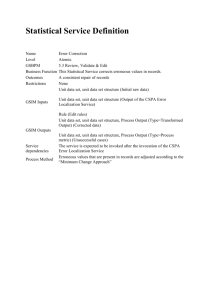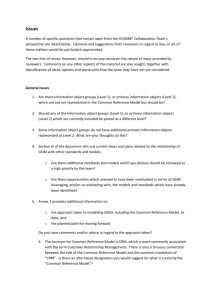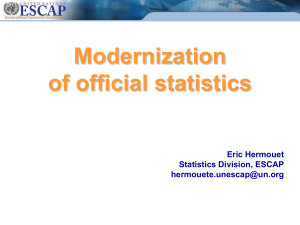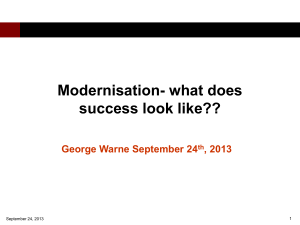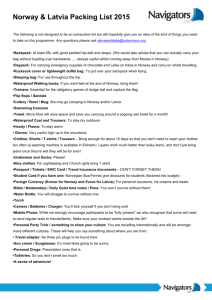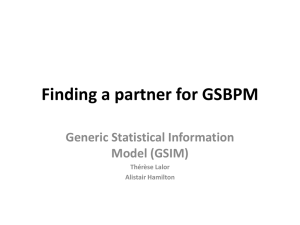The use of GSIM in Statistics Norway
advertisement
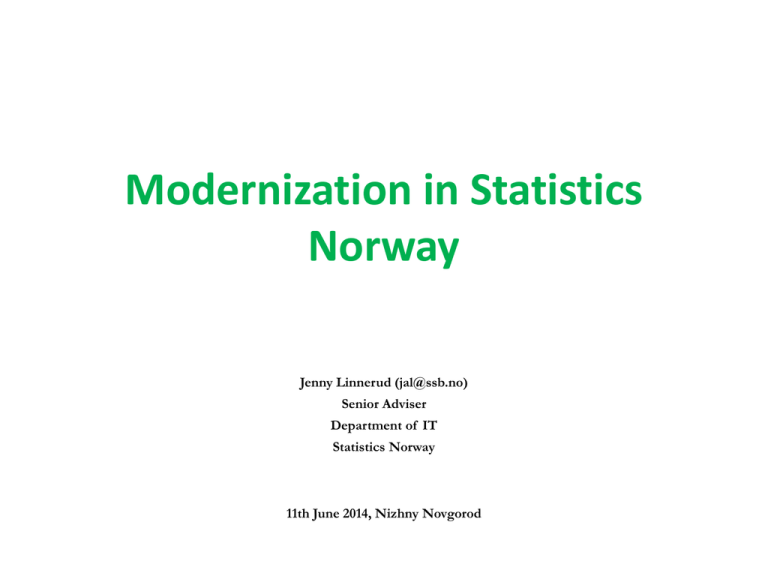
Modernization in Statistics Norway Jenny Linnerud (jal@ssb.no) Senior Adviser Department of IT Statistics Norway 11th June 2014, Nizhny Novgorod The Statistics Act (1989) • Statistics Norway’s tasks – Identify and prioritise needs for official statistics – Coordinate Norwegian statistics compiled by government agencies – Develop statistical methods, conduct analysis and carry out research – Provide information for statistical use for research purposes and public planning. – Be responsible for international statistics cooperation Plans 2014 • European Peer Reviews • Escalation of Lean • Improve portfolio and project management • Development of standardized solutions to improve efficiency Lean • Case 1: Efficient maintenance of the business register • Case 2: Improving data collection specifications • Case 3: Tracking respondents in sample surveys • Case 4: Digital communication in data collection • Case 5: Respondent support service IT Cooperation • International – Statistical Network: New Zealand, Australia, Canada, Sweden, Norway, United Kingdom, – Modernisation Committee on Production and Methods – Modernisation Committee on Standards – Nordic cooperation International Standards • GSBPM • GSIM • CSPA • SDMX & DDI Why do we need a BPM? • To define and describe statistical processes in a coherent way • To compare and benchmark processes within our organisation • To make better decisions on development of production systems • To optimize organisation and allocation of resources Statistics Norways business process model Modernisation and standardisation of statistical production Statistics Norways business process model Specify needs Develop and design Build Collect Process 1 2 3 4 5 Determine need for information Outputs 1.1 Consult and confirm need Disseminate Analyse 6 7 Prepare data for dissemination database Build and enhance process components Classify and code Acquire domain intelligence 2.1 3.1 Establish frame and registers, select sample 4.1 5.1 6.1 Frame, register and sample methodology Integrate production system with other systems Set up collection Micro-edit Produce statistics Produce product 2.2 3.2 4.2 5.2 6.2 7.2 Establish output objectives Data collection methodology Test production system Run collection Macro-control Quality assure statistics Release and promote product 1.3 2.3 4.3 5.3 6.3 7.3 Check data availability Process and analysis methodology Finalise collection Impute for partial non-response Manage customer queries 4.4 5.4 Interpret and explain statistics 1.2 1.4 2.4 Prepare business case Production system 1.5 2.5 3.3 Finalise production system 3.4 Calculate weights and derive new variables 5.5 6.4 Prepare statistics for dissemination 6.5 Finalise content 6.6 7.1 7.4 Complete documentation on our Intranet We need consistent information • Modernisation of statistics requires: – reuse and sharing of methods, components, processes and data repositories – definition of a shared “plug-and-play” modular component architecture • The Generic Statistical Business Process Model (GSBPM) will help us determine which components are required. • GSIM will help us to specify the interfaces. 11 GSBPM in Statistics Norway Streamlining Statistics Production Categorising systems Java SAS Oracle Fame “Projectplanning”: - Jira Document centers: Confluence (Trac, Wiki) Windows-server SIV/SIL Blaise Altinn (Idun, Kostra) SFU FDM Norsamu (Trekkbas) Telefinn SMIE SERES Presys Produktregister Metadataportals: - Vardok - Datadok - Stabas - ssb.no (About statistics) ssb.no ISEE ISEE Driller Verify SELEKT - statistic register -Google analytics Stat. Bank X12-Arima Tau-Argus Mu-Argus SAS Insight Stat. population registers: - National register - The Central CoordinatingMS Office Register for Legal Entities SmartDraw - GAB – Landed property, ArcGIS Address, Dwelling (map) Websak SPSS Adobe Service Manager (Helpdesk, OTRS) LDA-app Summary The international standards and cooperation help us to • plan new statistics • prioritize new projects (portfolio management) • improve existing work processes in statistical production • reduce our portfolio of IT-systems • reduce risk • make a more complete business architecture • train and integrate new & existing staff.
